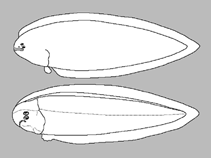Symphurus holothuriae Chabanaud, 1948
Uploaden van uw Foto's en video's
Google afbeeldingNo image available for this species;
drawing shows typical species in Cynoglossidae.
Google afbeeldingNo image available for this species;
drawing shows typical species in Cynoglossidae.
Classificatie / Names Lokale namen | Synoniemen | Catalog of Fishes(Genus, Soort(en)) | ITIS | CoL | WoRMS | Cloffa
> Pleuronectiformes (Flatfishes) > Cynoglossidae (Tonguefishes) > Symphurinae
Etymology: Symphurus: Greek, syn, symphysis = grown together + Greek, oura = tail (Ref. 45335); holothuriae: Named for its type locality, off Holothuria Bank.
Etymology: Symphurus: Greek, syn, symphysis = grown together + Greek, oura = tail (Ref. 45335); holothuriae: Named for its type locality, off Holothuria Bank.
Environment: milieu / climate zone / depth range / distribution range Ecologie
marien demersaal. Subtropical
Verspreiding Landen | FAO regio's | Ecosystemen | Voorkomen | Point map | Introducties | Faunafri
Eastern Indian Ocean: NW Australia.
Grootte / Gewicht / Leeftijd
Korte beschrijving Determinatiesleutels | Morfologie | Morfometrie
Dorsale zachte stralen (totaal) : 84; Anale zachte stralen: 70; Wervels: 46. This species is distinguished from all its congeners by the following set of characters: ID pattern 1-2-3-2-2; caudal-fin rays 12; vertebrae. 9 (3 + 6) abdominal. 46 total; hypurals 4; D 84, A 70; longitudinal scale rows 60; transverse scale rows 25; scale rows on head posterior to lower orbit 16; body elongate (BD 25.7% of SL); preanal length long (PAL = 27.6% of SL); upper head lobe equal in length to lower head lobe; head long (HL = 24.0% of SL), head length longer than head width (HW/HL = 0.97); postorbital length long (POL of 75.9% HL); snout short (SNL = 14.3% of HL, SNL/ED = 1.45) and slightly blunt anteriorly; dorsal-fin origin at vertical through posterior margin of upper eye; predorsal length short (PDL = 19.7% of HL); eyes unequal in position with anterior margin of upper eye noticeably in advance of anterior margin of lower eye; a well-developed fleshy ridge on posterior part of ocular-side lower jaw; body pigmentation yellowish-green on both sides (Ref. 126065).
Levenscyclus en paargedrag Maturiteit | Voortplanting | Paaien | Eieren | Fecunditeit | Larven
Hoofdreferentie
Upload your references | Referenties | Coördinator | Medewerkers
Lee, M.-Y. and T.A. Munroe, 2021. Unraveling cryptic diversity among shallow-water tonguefishes (Pleuronectiformes: Cynoglossidae: Symphurus) from the Indo-West Pacific region, with descriptions of five new species. Zootaxa 5039(1):1-5.5 (Ref. 126065)
Status op de Rode Lijst van het IUCN (Ref. 130435: Version 2024-2)
Onvoldoende gegevens (DD) ; Date assessed: 22 February 2019
CITES
Not Evaluated
Gevaar voor de mens
Harmless
Gebruik door de mens
FAO - Publication: search | FishSource |
Meer informatie
Trophic ecology
Voedselitems
Dieetsamenstelling
Voedselconsumptie
Food rations
Predatoren
Voedselitems
Dieetsamenstelling
Voedselconsumptie
Food rations
Predatoren
Ecology
Ecologie
Ecologie
Population dynamics
Groeiparameters
Max. ages / sizes
Length-weight rel.
Length-length rel.
Lengtefrequenties
Massaconversie
Rekrutering
Abundantie
Groeiparameters
Max. ages / sizes
Length-weight rel.
Length-length rel.
Lengtefrequenties
Massaconversie
Rekrutering
Abundantie
Life cycle
Voortplanting
Maturiteit
Maturity/Gills rel.
Fecunditeit
Paaien
Spawning aggregations
Eieren
Ontwikkeling van de eieren
Larven
Larvale populatiedynamiek
Voortplanting
Maturiteit
Maturity/Gills rel.
Fecunditeit
Paaien
Spawning aggregations
Eieren
Ontwikkeling van de eieren
Larven
Larvale populatiedynamiek
Anatomy
Kieuwoppervlak
Brain
Otolith
Kieuwoppervlak
Brain
Otolith
Physiology
Body composition
Nutrients
Zuurstofverbruik
Zwemtype
Zwemsnelheid
Visual pigments
Fish sound
Diseases & Parasites
Toxicity (LC50s)
Body composition
Nutrients
Zuurstofverbruik
Zwemtype
Zwemsnelheid
Visual pigments
Fish sound
Diseases & Parasites
Toxicity (LC50s)
Genetics
Genetica
Heterozygosity
Erfelijkheid
Genetica
Heterozygosity
Erfelijkheid
Human related
Aquaculture systems
Aquacultuurprofielen
Kweeklijnen
Ciguatera cases
Stamps, coins, misc.
Aquaculture systems
Aquacultuurprofielen
Kweeklijnen
Ciguatera cases
Stamps, coins, misc.
Tools
E-boek | Veldgids | Determinatiesleutels | Lengtefrequentie Tool | Levenscyclus tool | Verspreidingskaart | Classification Tree
| Catch-MSY |
Speciale rapporten
Bekijk gegevens voor het houden in een aquarium | Bekijk Fact Sheets voor de soort | Bekijk Aquacultuur Fact Sheets
Download XML
Internetbronnen
AFORO (otoliths) | Aquatic Commons | BHL | Cloffa | BOLDSystems | Websites from users | Bekijk FishWatcher | CISTI | Catalog of Fishes: Genus, Soort(en) | DiscoverLife | ECOTOX | FAO - Publication: search | Faunafri | Fishipedia | Fishtrace | GenBank: genoom, nucleotide | GloBI | Google Books | Google Scholar | Google | IGFA World Record | MitoFish | Otolith Atlas of Taiwan Fishes | PubMed | Reef Life Survey | Socotra Atlas | Tree of Life | Wikipedia: ga naar, zoek | World Records Freshwater Fishing | Zoobank | Zoological Record
Estimates based on models
Fylogenetische diversiteitsindex (Ref. 82804): PD50 = No PD50 data [Uniqueness, from 0.5 = low to 2.0 = high].
Bayesian length-weight: a=0.00389 (0.00190 - 0.00797), b=3.17 (3.00 - 3.34), in cm total length, based on LWR estimates for this Genus-body shape (Ref. 93245).
Trofisch niveau (Ref. 69278): 3.1 ±0.4 se; based on size and trophs of closest relatives
Weerstandsvermogen (Ref. 120179): Hoog, minimale populatieverdubbelingstijd minder dan 15 maanden (Preliminary K or Fecundity.).
Fishing Vulnerability (Ref. 59153): Low vulnerability (10 of 100).




